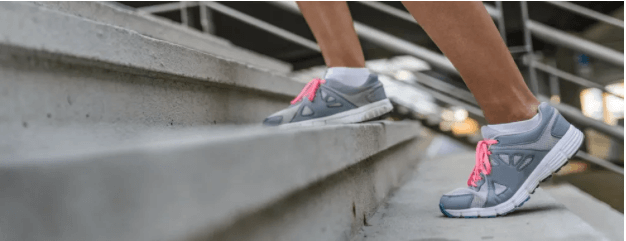Do you have pain going up and down the stairs? Are you extra cautious going up the stairs due to fear of falling? Climbing stairs is a daily activity that is fundamental to getting around the community. Although stairs seem like a simple activity, your body uses various muscles to complete the movement. This article below will review each component of the stair negotiation process.
What is the Gait Cycle of a Stair Ascent and Stair Descent?
- Ascent: Weight Acceptance -> Pull Up Phase -> Forward Continuance -> Foot Clearance – >Foot Placement
- Descent: Weight Acceptance -> Forward Continuance -> Controlled Lowering -> Leg Pull Through -> Foot Placement
What are the Major Muscles Activated During the Stair Gait Cycle?
- Quadriceps Femoris
- Hamstrings
- Tibialis Anterior
- Gastrocnemius
- Psoas Major
- Gluteus Medius/Maximus
What is Happening During a Stair Ascent?
- Raising the body on to the stair above is brought about by the contraction of the soleus, quadriceps femoris, hamstrings and gluteus maximus. The gluteus medius at the same time prevents the body falling on to the unsupported side.
- The tibialis anterior dorsiflexes the foot during the swinging phase and helps the limb to clear the stair on which the supporting limb is placed.
- The hamstrings flex the leg at the knee in the early part of the swinging phase and control the terminal part of extension at the knee at the end of this phase.
- Both erectores spinae contract twice in each step and control the forward bending of the body at the vertebral column. (Watson & Joseph 1967)
What is Happening During a Stair Descent?
- The body is lowered on to the stair below by the controlled lengthening of the soleus and quadriceps femoris; the gluteus medius at the same time prevents the body from falling on to the unsupported side.
- The tibialis anterior inverts the foot at the beginning of the supporting phase as the toe is placed on the stair below and dorsiflexes the foot in the middle of the swinging phase.
- The hamstrings control the extension of the leg at the knee during the middle of the swinging phase.
- Both erectores spinae contract twice in each step and prevent forward bending of the trunk at the vertebral column. (Watson & Joseph 1967)
As shown above, there are a lot of components to a successful completion of stairs. If you are experiencing pain or limitations when going up/down the stairs, Respire Physical Therapy can help. A Doctor of Physical Therapy will evaluate your individual body structures and function to determine the exact muscles that are limiting you. Call us today at 703-671-1871 or click here to request to schedule an evaluation and get back to doing what you love without pain.
Written By: Kevin Teng, DPT
Citations:
Joseph J, Watson R (1967) Telemetering electromyography of muscles used in walking up and down stairs. J Bone Jt Surg Br 49:774–780
Novak AC, Brouwer B. Sagittal and frontal plane joint moment profiles associated with stair ascent and descent in young and older adults. Presented at the 16th Biennial Conference for the Canadian Society of Biomechanics, Kingston, Ontario, June 2010.
Tags: physical therapist, falls church, alexandria, arlington, dmvphysicaltherapy, springfieldva, Physical Therapy, Numbness and Tingling



